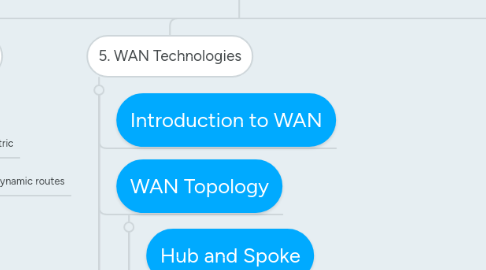
1. 2. Network Fundamentals
1.1. What is a network
1.2. OSI model explained
1.3. TCP/IP model explained
1.4. Ethernet technology
1.5. Basic of network cabling
1.6. Common network devices and their functions
1.6.1. routers
1.6.2. switches
1.6.3. hub and bridge
1.6.4. firewall
1.6.5. proxy server
1.6.6. load balancer
1.7. Network Speed and Topology
1.7.1. Network speed
1.7.2. Star
1.7.3. Mesh
1.7.4. Hybrid
1.8. IP Addressing
1.8.1. IPV4
1.8.1.1. Basic IP Addressing
1.8.1.2. IP Address classes
1.8.1.3. Subnetting IPV4
1.8.1.4. VLSM
1.8.2. IPV6
1.8.2.1. Basic of IPv6
2. 3. LAN Switching Technologies
2.1. How switch work
2.2. Basic config of Ciscco switch
2.3. VLANs
2.4. VTP
2.5. STP
2.6. Etherchannel
2.6.1. Static
2.6.2. PAGP
2.6.3. LACP
3. 4. Routing Technologies
3.1. How routers work
3.2. Administrative distance and Metric
3.3. Directly connected, static and dynamic routes
3.4. Default route
3.5. Network route
3.6. Host route
3.7. Floating Static
3.8. Router on a stick
3.9. RIP
3.9.1. RIP I
3.9.2. RIP II
3.10. OSPF
3.10.1. Part I
3.10.2. Part II
3.10.3. Part III
3.10.4. Part IV
3.11. EIGRP
3.11.1. EIGRP I
3.11.2. EIGRP II
3.11.3. EIGRP III
3.11.4. EIGRP IV
3.12. BGP
3.12.1. BGP I
3.12.2. BGP II
3.12.3. BGP III
4. 5. WAN Technologies
4.1. Introduction to WAN
4.2. WAN Topology
4.2.1. Hub and Spoke
4.2.2. Point to Point
4.2.3. Full meshed
4.3. WAN Connectivity
4.3.1. MPLS
4.3.2. MetroEthernet
4.3.3. Broadband PPPoE
4.3.4. PPP and MLPPP
4.3.5. Internet VPN
4.3.5.1. Site to Site VPN
4.3.5.2. Client VPN
4.4. Different types of WAN uplink connections
4.4.1. Single vs. Dual Homed
4.4.2. Dual homed
4.4.3. Single multi-homed
4.4.4. Dual multi-homed
4.5. Basic QOS concepts
4.5.1. Marking
4.5.2. Shaping
4.5.3. Policing
4.5.4. Device Trust
4.6. Basic of Point-to-point
4.7. Basi of VPN
5. 6. Infrastructure Services
5.1. DHCP
5.1.1. Server
5.1.2. Relay
5.1.3. Client
5.2. HSRP
5.2.1. Priority
5.2.2. Preemption
5.2.3. Version
5.3. VRRP
5.4. GLBP
5.5. NAT
5.5.1. Static
5.5.2. Pool
5.5.3. PAT
6. 7. Infrastructure Security
6.1. Port Security
6.1.1. Static
6.1.2. Dynamic
6.1.3. Sticky
6.1.4. MAX mac address
6.1.5. Violation actions
6.1.6. Err-disable discovery
6.2. Device Hardening
6.2.1. Local Authentication
6.2.2. Secure Password
6.2.3. Access to Device
6.2.4. AAA with TACACS+ and Radius
6.3. Access Lists
6.3.1. Standard
6.3.2. Extended
7. 8. Infrastructure Management
7.1. Basic parts and components of a Cisco device
7.2. Basic and Fundamentals of Cisco IOS
7.3. Cisco IOS command modes
7.4. Memory of routers
7.5. Cisco IOS upgrade
7.6. Backup and restore configuration
7.7. Configuring Banner
7.8. CDP and LLDP
7.9. SNMP
7.10. Syslog
7.11. ICMP echo-based IP SLA
7.12. Basic of SDN
7.13. APIC-EM
7.14. End of CCNA topic
8. 9. Last Word
8.1. Last word
9. 1. Introduction
9.1. Dedication
9.2. Introduction
9.3. ABOUT CCNA
9.3.1. What is CCNA?
9.3.2. 10 Types of CCNA Certification
9.3.3. Why aim for CCNA
9.3.4. Benefits of CCNA
9.3.5. CCNA exam tips and FAQs
